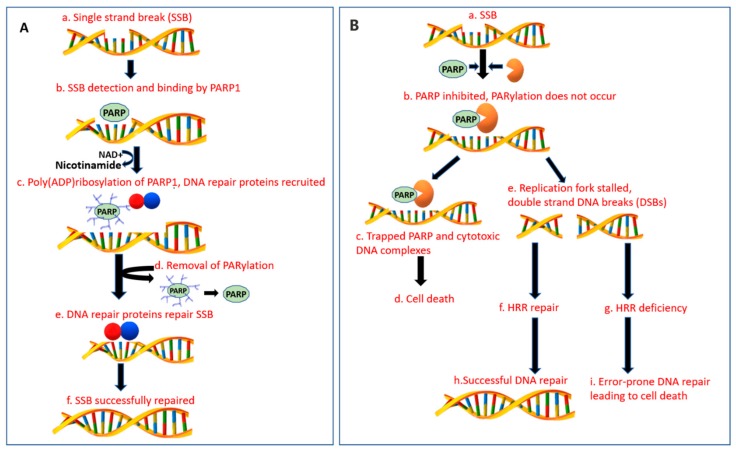Figure 1.
Mechanism of action of DNA damage repair in normal healthy cells and with PARP inhibitors. Abbreviations: SSB = single strand break, DSB = double strand break, DDR = DNA damage repair, HRR = homologous recombination repair, PARP = poly(ADP-ribose) polymerase, PARPi= PARP inhibitor, BER = base excision repair. (A) Normal DNA damage repair process: (a) In healthy cells, SSB mainly by BER pathway mediated by a family of enzymes known as PARP. (b) PARP-1 detects SSBs and binds to the DNA damage site via zinc motif fingers at the DNA binding domain. (c) PARP DNA binding activates its catalytic activity and utilization of NAD+ to synthesize poly ADP-ribose (pADPr) polymer formation on itself (autoPARylation) and other histone proteins. The pADPr polymers recruit DNA repair proteins, including XRCC1. (d) PARylation also reduces the affinity of PARP-1 for DNA binding, releasing it from the site of DDR. The pADPr polymers are lysed from PARP by enzymes such as PARG and ARH3, restoring its ability to detect and bind to DNA damage sites. (e) PARP removal from the site of DNA damage allows DDR effector proteins to bind at the site of damage leading to successful repair of DNA as depicted in (f). (B): (a) SSB in the presence of PARPi. (b) PARPi bind with the catalytic domain of PARP enzyme and inhibit the synthesis of pADPr formation and recruitment of DNA repair proteins. (c) PARPi also trap PARP-1 on the damaged DNA site, prevent its release and accumulate cytotoxic DNA complexes. (d) This eventually can culminate in cell death. (e) When BER mechanism is dysfunctional, unrepaired SSBs stall the replication fork leading to DSBs formation. (f–i) The concept of synthetic lethality. (f,h) In BRCA 1 or 2 heterozygous (BRCA+/−) or BRCA wild-type (BRCA+/+) cells, the DDR occurs through the error-free HRR pathway averting the cell death. (g) In the presence of BRCA1 or BRCA2 mutations (BRCA−/−) and other mutations with a similar phenotype of defective HRR, the cells are unable to repair DSBs through HR pathway. (i) Repair alternatively occurs through the error-prone pathway of NHEJ leading to cell cycle arrest, genomic instability and lethality.

